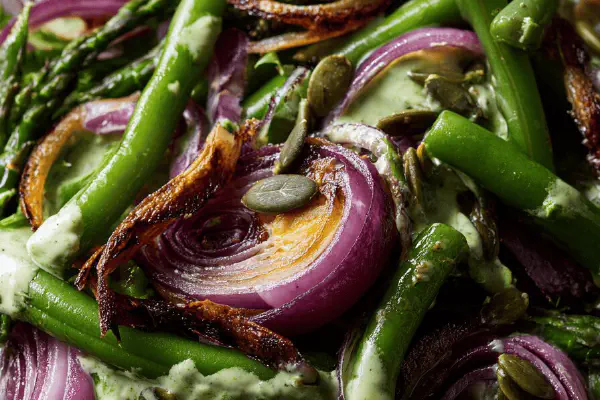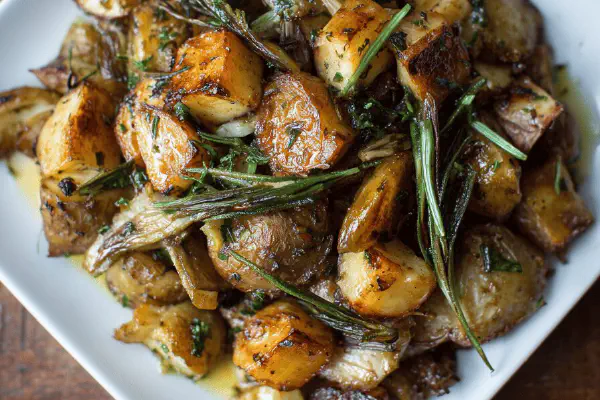Green Veggie Salad with Roasted Shallots

By Emma
Certified Culinary Professional
Ingredients
Vinaigrette
- 2 shallots, finely chopped
- 50 ml olive oil
- 25 ml apple cider vinegar
- 3 ml honey
- salt and cracked black pepper
Salad
- 200 ml plain yogurt
- 10 ml dried tarragon
- 400 g asparagus, trimmed
- 280 g slender green beans, trimmed
- 1 head radicchio, chopped thin
- 35 g watercress
- 30 g toasted pumpkin seeds
About the ingredients
Method
Vinaigrette
- Heat oil over medium-high in small pan. Toss in shallots. Fry, stirring occasionally, until deep golden, almost caramelized. Don’t burn. Smells nutty and sharp. Remove from heat. Add vinegar and honey. Return pan to flame just long enough to bubble up—about 8 seconds. Remove promptly. Season with salt and pepper. Let cool slightly.
Dressing
- Mix yogurt and tarragon in bowl. Salt, pepper. Adjust if tangy enough. Set aside.
Veggie prep
- Boil large pot salted water. Test asparagus by piercing the thick end with fork. Want firm-tender, not limp. Usually about 2-3 minutes depending on thickness. Immediately plunge into ice bath to halt cooking. Shocks color bright. Drain and pat dry. Chop asparagus into 3 equal parts.
- Same pot, bring fresh water to boil if needed. Cook green beans. They're thin so 3-4 minutes max. Should yield crisp snap when bitten. Ice bath again, drain thoroughly.
- Combine beans and asparagus in bowl. Toss half the vinaigrette here. Salt and pepper. Toss gently but thoroughly.
- Arrange yogurt-tarragon on plates, thin layer like paint. Over top the dressed veggies, then scatter radicchio and watercress. Drizzle remaining vinaigrette over all.
- Finish with pumpkin seeds sprinkled across. Crunch balances the softer greens. Those seeds have a mild earthiness, nice twist from almonds.
- Serve immediately. If left too long, veggies lose snap, dressing waters down.
- Pro tip, if pumpkin seeds missing, toasted sliced almonds or walnuts work fine. If no radicchio, endive or bitter chicory fine substitutes but adjust amount to taste.
- For yogurt, Greek style or whole milk preferred for creaminess. Low fat can be too thin, may thin with spoon of mayo or sour cream if needed.
- Off days, if shallots not oil caramelized well, sauce tastes raw and harsh. Watch color more than time. They should be soft, golden, slightly crispy at edges—bell-like aroma. Don't rush. That step sets base flavor.
Cooking tips
Chef's notes
- 💡 Shallots need patience. Heat olive oil slow on medium-high. Look for edges going translucent with tiny bubble forming. Color shifts from pale to golden, lightly crispy edges smell sweet-nutty. Don’t rush to caramelize or they turn bitter. Vinegar-honey splash happens off heat briefly then back quick to bubble—8 seconds tops. Pull immediately or sharp harsh notes linger.
- 💡 Blanching veggies—not exact stopwatch. Test asparagus firm but tender by piercing thick end with fork. Takes 2-3 minutes depending thickness. Green beans thin, 3-4 max, want crisp snap. Ice bath mandatory. Stops carryover cooking, locks bright green. Pat dry well or dressing waters down. Toss vinaigrette into half veggies for seasoning balance, prevents over-sogginess after plating.
- 💡 Yogurt: Greek or whole milk only, thick style. Thin yogurt pools, ruins texture. Tarragon dried, gently crushed avoids herbal bite. Fresh tarragon needs cut back to avoid sharp green notes. Stir salt and pepper into yogurt mix before plating; layering flavors here, make each element stand apart visually and texturally.
- 💡 Seed choices matter for crunch. Toasted pumpkin seeds bring earthiness without overpowering. Almonds imply sweetness, walnuts heavier. If nuts unavailable, quickly toasted sunflower seeds work. Sprinkle last to keep crunch intact. Pumpkin seeds different texture than almonds, lighter, less dense but some bitter notes.
- 💡 Shallot caramelization sets base flavor. Watch carefully, edges translucent then edges crisp lightly, small bubbles appear on shallots, hint of bell-like aroma. Raw sharpness replaced by mellow fat notes. Miss timing and sauce tastes flat or harsh. Layer flavors patiently; don’t rush this step. Color more reliable than time.
Common questions
How do I know shallots are cooked right?
Visual cues key. Shallots turn golden with slightly crispy edges; smell nutty, sweet not burnt. Small bubbles on shallots. Soft but hold shape. Too fast heat burns, taste harsh. Don’t trust timer alone. Look, smell, feel.
Can I use other greens besides radicchio?
Sure. Endive or bitter chicory swap well but adjust amount for bitterness impact. Watercress can be subbed with arugula, though peppery notes shift flavor balance. Leaf textures differ; thinner or tougher greens shift mouthfeel. Experiment but taste as you go.
What if dressing gets watery?
Usually due to thin yogurt or wet veggies. Use thick Greek or whole milk yogurt only; low fat runs too thin. Pat veggies dry after ice bath, drain well. Toss vinaigrette in half veggies, not all at once. If needed, add pinch mayo or sour cream for holding dressing texture.
Can leftovers keep?
Salad best fresh. Veggies lose snap, dressing waters down fast. Store separated if possible. Pump seeds lose crunch quickly; add fresh when serving again. Yogurt dressing can sit 1-2 days refrigerated but salad assembly after thawing or chilling improves results a lot.



